
Can Life360 Track You When Your Xiaomi Redmi 13C 5G is off? | Dr.fone

Can Life360 Track You When Your Xiaomi Redmi 13C 5G is off?
Did you know that your Xiaomi Redmi 13C 5G tracks your location even when turned off? And if you’re a member of any social media network, it means you could be tracked. Do you like to have your privacy? Do you want to protect your kids from being tracked by strangers?
Of course Yes! Well, then you should know that Your Xiaomi Redmi 13C 5G can track your movements even when switched off. But is that true?
In the event that you switch off your Xiaomi Redmi 13C 5G, the GPS function will also be disabled. As a result, it will not be able to determine your position when your Xiaomi Redmi 13C 5G is turned off. However, Life360 will continue to provide the most recent location data that was uploaded to your account.
Should we trust Life360, the social media company that recently merged with Google, to protect our privacy? Let’s take a look at the facts.
- Part 1: What Is Life360 And How Does It Work?
- Part 2: Does life360 work if the phone is off?
- Part 3: 3 Ways to Stop Life360 from Tracking You

Part 1: What Is Life360 And How Does It Work?
The one app that kids hate and parents adore is called Life360. Life360 is monitoring software that can be downloaded into your Xiaomi Redmi 13C 5G and used by the individuals who are part of your Family Circle to monitor your location and the location of anybody else who is part of your Family Circle.
The app works by sending a request to your cellular carrier to get your location and then sending that information to the Life360 servers. In addition, life360 will store your location and send it to your social networks automatically.
Life360 is not required to track your location, but it is required to send your location to your social networks.
If you want to know more about Life360, check out our Life360 Review.
When it comes to privacy, many people are becoming more aware of how it is being violated. As a result, there’s no need to worry about whether or not the monitoring app in concern is as trustworthy as Life360.
Disconnecting from Life360 is as simple as turning off your Xiaomi Redmi 13C 5G and preventing the app from following and reporting your every step. Unfortunately, it also means that no one can see where they are about one another or how long it has been since they last updated their position.
If the necessity ever arose, such an undertaking may be useful for maintaining one’s privacy. However, customers have no idea that Life 360 may still be used to monitor them by other people.
Premium users will still have access to the last 30 days’ worth of location data, so the other person will be able to see where you were last seen.
Part 3: 3 Ways to Stop Life360 from Tracking You
1. Low Data Consumption
Disabling Life360’s Wi-Fi and Data may result in a warning to parents that their children are offline so that they can keep an eye on their kids. Does life 360 drain the battery? Low data mode is a better option for turning off life360 without alerting your parents. Go to the Settings and locate Life360; however, do not deactivate the exact location.

Alternatively, you should disable background app refresh, mobile network, physical activity, and WIFI to save battery life. An issue with your Internet connection will come up instead of location stopped in this situation. So don’t connect to any Wi-Fi at all.
2. Fake Locations
Using location spoofing applications on an Android smartphone, your kids can fool you into thinking they’re somewhere else. Dr.Fone - Virtual Location is a location spoofing application that will trick you into thinking that you are in a different location than you really are. The GPS position of the Xiaomi Redmi 13C 5G device will be updated to reflect the new place that you have chosen thanks to the software. It is worth noting that Dr. Fone - Virtual Location for iOS may also enable you to imitate GPS movement.
It has several other noticeable features that can help you in your daily life.

3. Setting Wi-Fi and Data Services to “Off.”
Another typical method kids use to prevent their parents from monitoring their position is to disable Life360’s Wi-Fi and Data. It works like this. If you don’t want applications updating in the background, enable power-saving mode.
Use a wired connection. Adolescents can turn off Wi-Fi and data when using the Life360 app on an iPhone. Go to Settings, look for Life360, and disable Cellular Data, Background Refresh, and Motion & Fitness. You’ll be able to keep track of where you are on Life360.

All these methods can be used to Stop Life360 from Tracking You. However, the best all-in-one solution is a third-party application called Dr.Fone. This Virtual Location Software helps you keep your tracking off, but you can also fake your location very easily in minutes.
Conclusion
Can you track a phone if the location is off? Life360 has become a standard feature of many smartphones. Parents often use it to monitor their children’s location. The fact that Life360 can be used to track users is quite disturbing. The good news is that there are ways to stop Life360 from tracking you. The best and all-in-one solution is a third-party application called Dr.Fone - Virtual Location .
What is Geo-Blocking and How to Bypass it On Xiaomi Redmi 13C 5G?
Have you ever entered a website and can’t access it because it is unavailable in your area? This is what geo-blocking means. If you want to know more about geo-blocking, you have come to the right article. This article provides the definition, symbols, function, type, and how to bypass a geo-blocked site.
Encryption is often used in geo-blocking as a means of protecting material that is restricted to users in just certain locations. In its long existence, the method has been met with several obstacles. These obstacles will be discussed in the next sections!

Part 1. What is Geo-Blocking?
This section will give you the definition of geo-blocking. It will also show how websites inform viewers that they are in geo-blocking areas.
Definition of Geo-Blocking
Geo-blocking is the practice of restricting online access to certain users depending on where in the world they happen to be physically located. Telecommunications firms, websites, and other content providers and intellectual property owners often use this method for copyright protection. To monitor and enforce geo-blocks, databases that map out IP addresses’ geographical locations are often employed.
Understanding the Main Symbols and Elements
You sometimes can’t access a site because it isn’t available in your area. This is the main element carried by geo-blocking.
Every online-surfing tool has a unique identifier called “IP address”. The address can identify the Xiaomi Redmi 13C 5G devices’ geographical location. When users access a website, their devices send their IP addresses to the online servers. The servers read if the IP addresses are included in the allowed list and determine whether to allow the visitors to view the content.
The visitors usually know they are geographically limited through the website’s displayed outcomes, a poster indicating that the service is unavailable in the location. Take the geo-banned access by Airbnb as an example below.
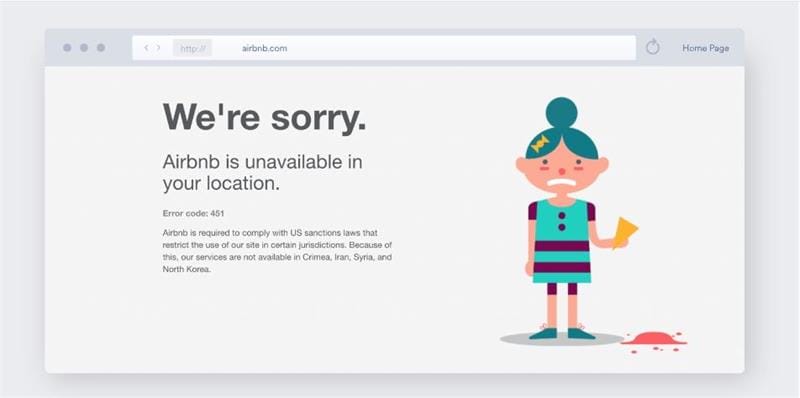
Although Airbnb has been criticized for posing a threat to the availability of low-cost lodging in metropolitan areas, it has proven to be a useful resource for travelers. However, not everyone can use it; for instance, it is unavailable in Iran due to US sanctions.
Part 2. How Does Geo-Blocking Work?
When a firm, rather than a government, is responsible for geoblocking, IP addresses are often the first line of defense. Your IP address is like a street address, revealing where you live.
IP addresses are numerical identifiers that distinguish each machine on the internet. Your computer’s IP address is sent to the server of the website you visit so that it may supply the required data.
You’ll be assigned an IP address when you sign up for an Internet Service Provider. It is possible to pinpoint the location of your device using its IP address, albeit the degree of precision may vary. Websites use the IP address to determine whether you can read their content. They will thus refuse your request if you are using an IP address that’s not on their approved list.
Part 3. Common Types of Geo-blocked Content
The difficulty stems from legal hurdles, including copyrights, licenses, and territorial disputes. Certain streaming services may not make all of their offerings accessible in all regions, or a major online shop may restrict some of their offerings to customers in just one geographic area.
Youtube
Users who upload videos can restrict access to them in certain countries. This nearly usually indicates that a business has chosen that you shouldn’t be able to see a video because of where you are located.

Spotify
You may be trying to find a method to unblock Spotify because you want to listen to unavailable music in your country or because the app has been prohibited in your area.

Live Sports
Big events may be aired exclusively by one company, which means you may be forced to pay to access certain material or go through annoying subscription hoops.

Pandora
Do you want to tune in to this online radio and music station? You can’t access it anywhere in Europe because of a regional firewall.

Porn sites
Artists from porn sites can now geo-block their movies, much like YouTube users do. Some porn sites have been outlawed in several countries, including Egypt and Pakistan, where the vast majority of the population resides.
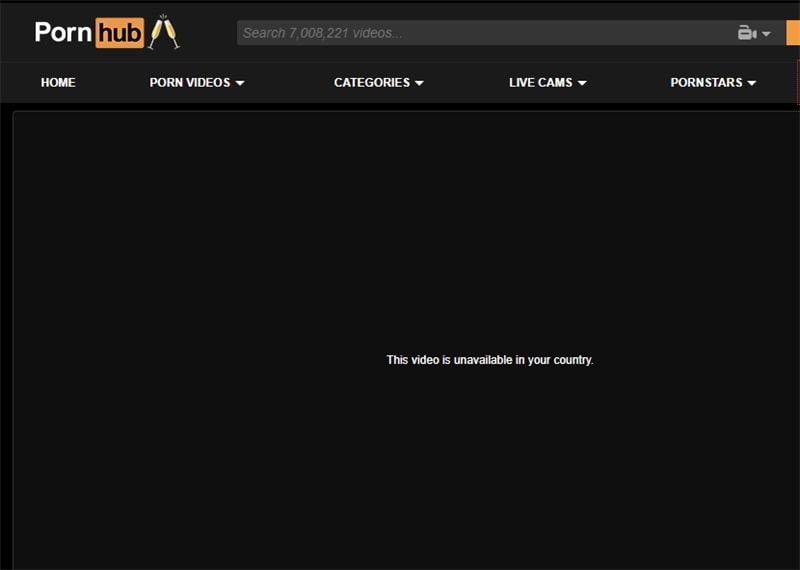
Amazon
Amazon Prime geo-blocks other services as well as its streaming content. Games, ebooks, software, audiobooks, and other digital materials like TV and movies may be licensed and copyrighted. Amazon Prime prevents certain VPN IPs from accessing foreign content, including Netflix.

Part 4. Tips to Bypass Geo-Blocking
While certain sites may be blocked in your country, there are still methods to access the full functionality of the web. What exactly are they, and how do you go about getting them? Here’s more reading material.
Method 1. Use Smart Domain Name System (DNS)
Clever DNS can evade geoblocking if your smart TV, streaming box, or gaming console doesn’t support VPNs or proxy servers. Some home routers can generate VPN connections, but not all.
By changing your DNS address, clever DNS may alter your device’s virtual location. Smart DNS replaces your Internet provider’s DNS server. Netflix.com’s IP is not netflix.com. You’ll acquire the smart DNS provider’s transparent DNS proxy IP. Netflix thinks you’re in the US since this proxy server is.
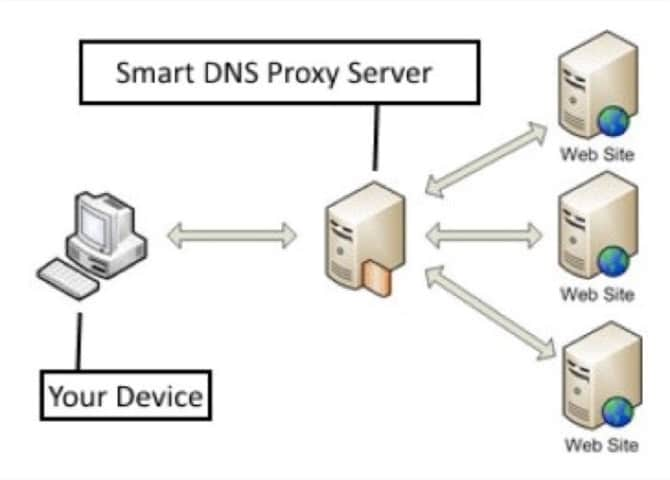
Method 2. Connect to Proxy Servers
Rather than connecting you directly to the server housing the material you want, a proxy server functions as an intermediary. A proxy server does what its name implies: it acts on your behalf to get access to the data and then forwards it to you. Proxy servers, especially those in foreign countries, may be used to get around geographical restrictions.
Depending on the kind of proxy server you use, you may or may not be able to conceal your IP address when surfing the web. Proxy servers are available online and may be accessed from any web browser. Setting up a proxy server is easy, but your activity may still be vulnerable since proxies don’t secure your data.
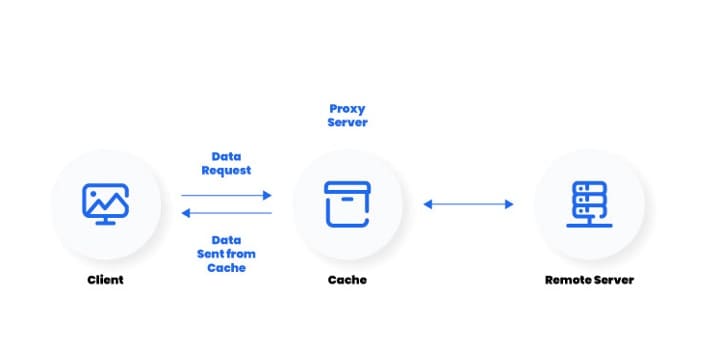
Method 3. Use the Tor Browser
In addition to using a VPN, you may use the anonymous Tor browser. The Tor browser links to the Tor network, a collection of computers that collaborate to conceal your online footprint by relaying your traffic via several intermediary nodes.
Tor employs a technique called “onion routing” to conceal its users’ identities. Since more time is required to traverse these additional levels, your internet speed may suffer as a consequence.
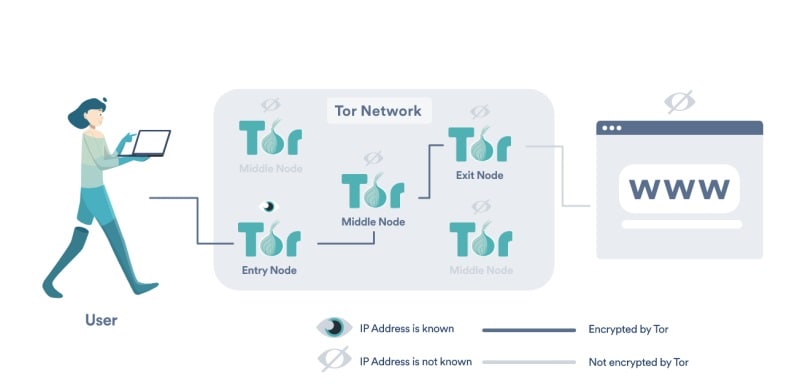
Method 4. A Good VPN Connection
A virtual private network (VPN) may hide your online identity and protect your data by encrypting your connection. VPNs allow you to get around geographically restricted material by redirecting your connection via a server in another country. This will allow you to connect to VPN servers in other countries, such as the United States, the United Kingdom, or Australia.
With effective VPN tools , you can surf the web anonymously, unblock geo-blocked content, and watch your favorite programs abroad. There are several advantages to utilizing a VPN, particularly when you travel or use public Wi-Fi, and they are simple to set up.
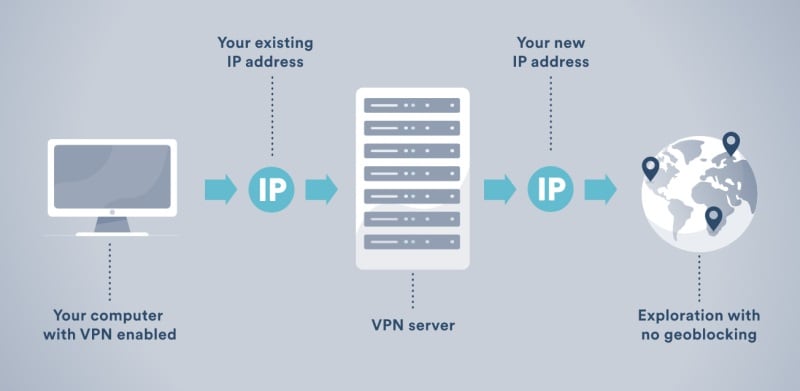
Part 5. FAQs About Geo-Blocking
Here are the answers to four questions that you might ask about geo-blocking.
1. Is Geo-Blocking Legal?
Yes. It’s legitimate. Limiting access to websites and services based on a user’s location is lawful. This practice is routinely used in nations like China to prevent citizens from seeing politically sensitive material. Legal arrangements, such as licensing agreements, may also be enforced by geo-blocking.
2. Is Bypassing Geo Blocking Illegal?
It depends. Depending on the situation, the nation, the purpose of the use, and the technique used, geo-blocking circumvention may be against the law. Copyright regulations prohibit users from accessing material beyond its designated location, yet many providers are reluctant to penalize users for doing so.
3. What’s the Difference Between Geo-Fencing and Geo-Blocking?
Geo-fencing is to create digital fences on which to base real-world judgments about where to go. One may draw a boundary around it using longitude and latitude lines on a map to easily establish who is permitted inside a certain region. Restricting access to material based on a user’s physical location is called “geo-blocking.”
4. Is Geo-Restricted the Same as Geo-Blocking?
They are the same. Restricting a user’s ability to access certain online resources depending on their location is known as geo-blocking or geo-restriction. To safeguard their license agreements, foreign media streaming firms often use the practice of geo-blocking.
Conclusion
For several reasons, media and content producers use geo-blocking. Although geo-blocking is unlikely to ever go out of style, there are techniques to circumvent it. Use a virtual private network (VPN) to bypass geo-restrictions on the material you want to watch. Using a Virtual Private Network (VPN), a proxy server, the Tor network, etc., your online location may be hidden or masked.
Geo-blocking controls. It’s both useful and abused. Website banning discriminates and manipulates. Geography may be annoying and frustrating. Sadly, they may always be in style. You don’t have to tolerate them!
How To Use Special Features - Virtual Location On Xiaomi Redmi 13C 5G?
Wondershare Dr.Fone - Virtual Location comes with multiple unique features that can be used to enhance the flow of spoofing location. With all these amazing features, you can easily change your iOS location without blinking an eye. Rather than making things complicated, Dr.Fone makes it easy for you to manage operations when you perform actions like changing Android locations.
Part 1: Circle Route (For Multi-Stop Route)
The circle route feature is under the multi-stop route mode. When your starting point is close to the ending point, a pop-up asks if you want to set up a circle route. Click Yes to create a circular path on the map.

Part 2: Realistic Mode (For One-Stop Route and Multi-Stop Route)
This particular feature makes the simulation look realistic with the ability to fluctuate the speed of the simulation. If you wish to turn on realistic mode for the one-stop or multi-stop route, look for the respective checkmark option in the panel on the left.

Part 3: Fluctuation Mode (For Teleport Mode)
Whenever you are teleporting your smartphone device to another location, you can try using the fluctuation mode feature offered against it. As you activate Teleport Mode from the top-right section and search for a location, you will discover the Fluctuation Mode toggle in the confirmation tab. Turn on the toggle to slightly switch the location from the selected point to show realistic motion.

Part 4: Cooldown Timer (For Teleport Mode and Jump Teleport Mode)
While teleporting the location of your smartphone to different places for playing games like Pokemon Go, you are bound to activate a cooldown timer within your location-changing app to show realistic movement. By locating the Cooldown Timer on the right pane of icons, activate it, and this feature will automatically calculate the cooling time by measuring the distance between your destination and the starting point.

It is recommended not to start the movement until the cooldown time is completed to avoid unnecessary bans. Moreover, you can also activate the Auto jump after cooldown in the Jump teleport mode after turning on the Cooldown Timer.
This option will automatically jump you to the next destination once the timer ends. It is helpful for games like Pokemon Go, where the game servers can detect frequent jumps with no cooldown time.
Part 5: Import/Export GPX File
You can also import and export specific navigated locations from Dr.Fone in the form of GPX files. While you can export GPX files for keeping a record of your location, you can also import such files for inserting specific locations to simulate or teleport to. Find out how you can import and export GPX files with this location-changing application:
Step 1Export the GPX File
If you have defined a proper location to simulate at a particular instant using Dr.Fone - Virtual Location, you can have this location exported by clicking the Export icon on the top of the left panel. This will open a window where you can set the location for saving the GPX file.

Step 2Import a GPX File
For importing a GPX file on the platform, click the Import button on the right pane. As this opens a window, select the GPX file you wish to import to the platform.
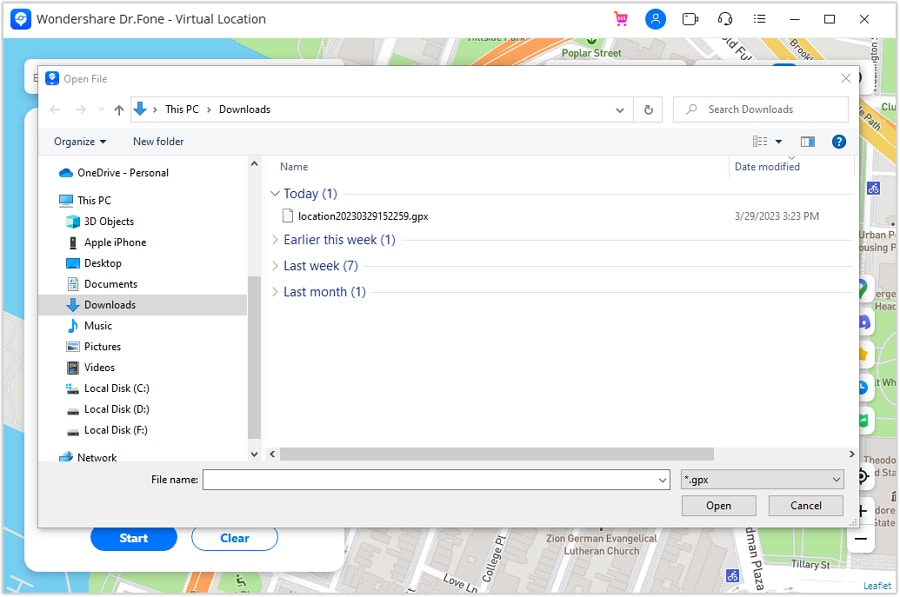
Step 3Wait for the File to be Read
Wait for a moment until Dr.Fone - Virtual Location recognizes the specific locations within the GPX file and displays them on the map.

Part 6: Historical Records
If you want to use a similar track record on your smartphone again, you can access the historical records saved on the platform for easy access.
Step 1Open Historical Records
Click the Historical Records button on the right pane to access the entire history involving the connected smartphone and the location spoofing platform.
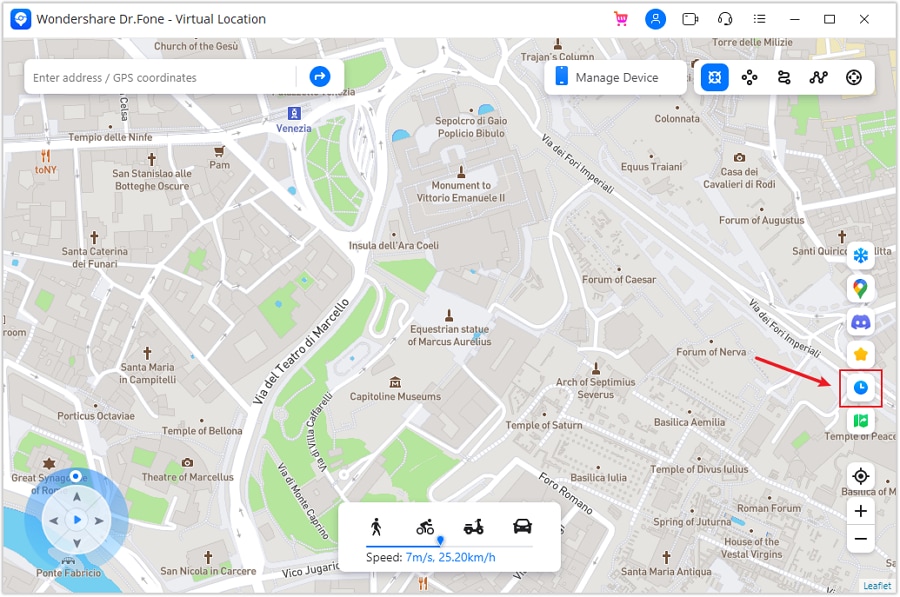
Step 2Access Any Location from the History
Select the Go button adjacent to any particular historical record to re-launch a similar simulation for the Xiaomi Redmi 13C 5G device. You can also click Clear All to delete all historical records.

Part 7: Favorite List
You can also set up favorite locations within the platform to define quick accessibility to your favorite locations. To do that, you have to follow the guidelines shown next:
Step 1Favorite Specific Locations
While setting up locations in Jump Teleport Mode, One-Stop Route, or Multi-Stop Route, you can tap on the Favorite icon adjacent to every marked location or favorite an entire route with the Favorite icon on the top of the left panel.
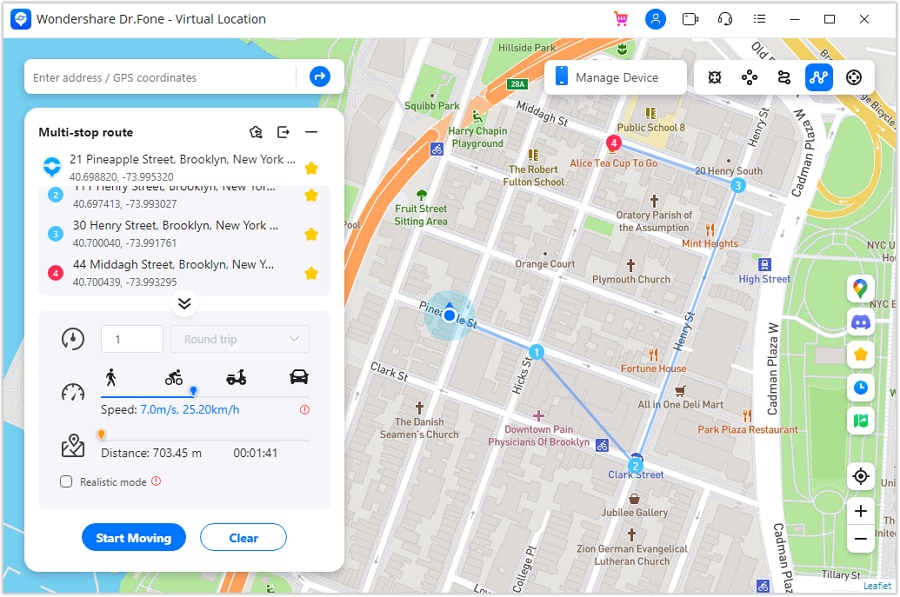
Step 2Access your Favorite Section
To look for your favorite locations, look for the Favorite icon on the right pane to open a list containing all locations you have marked. You can choose the Move option to automatically move into a particular location in no time.
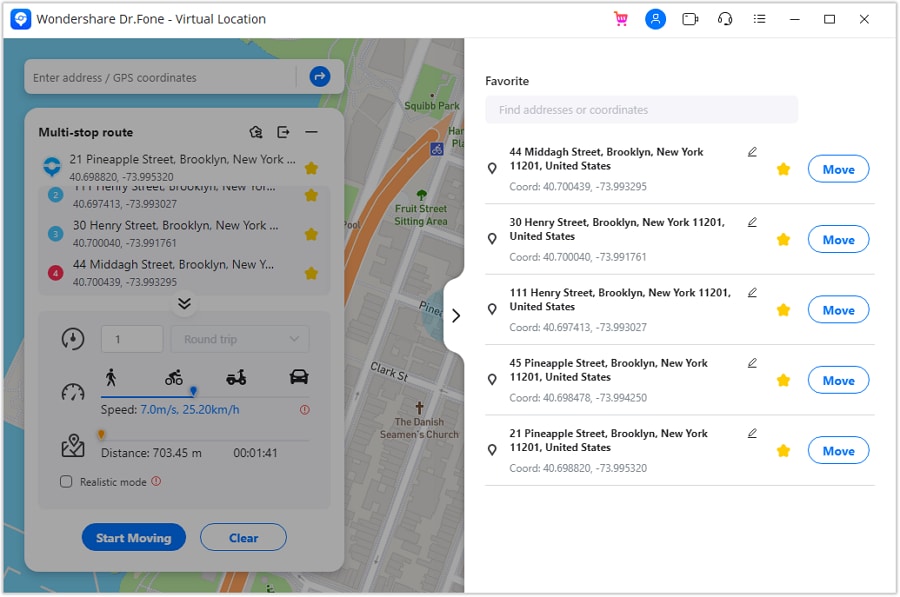
Also read:
- [New] 2024 Approved BenQ BL2711U Revealed Embracing the Future of 4K Technology
- [Updated] 2024 Approved Expert Tips to Enrich Virtual Meetings with Screen Sharing
- [Updated] Transforming Tweets Into Animated GIFs A Step-by-Step Guide
- 1. Seamless Music Transfer: Ultimate Guide to Syncing Your iTunes Library with an Android Device
- Apply These Techniques to Improve How to Detect Fake GPS Location On Nubia Red Magic 8S Pro | Dr.fone
- Commercial-Free Android Vision Capturer
- Debunking 6 Myths About Intel's Latest Processors
- How to Change Google Play Location On Realme 12 5G | Dr.fone
- How to Change Google Play Location On Realme GT Neo 5 | Dr.fone
- In 2024, How To Get the Apple ID Verification Code From Apple iPhone 8 Plus in the Best Ways
- Life360 Circle Everything You Need to Know On Honor X8b | Dr.fone
- Life360 Circle Everything You Need to Know On Samsung Galaxy S21 FE 5G (2023) | Dr.fone
- Looking For A Location Changer On Realme C33 2023? Look No Further | Dr.fone
- Strategies for Leveraging Big Data in Crisis Management Scenarios to Maintain Brand Equity During Challenging Times.
- The Complete Manual for Using Speech Recognition in Google Documents
- Title: Can Life360 Track You When Your Xiaomi Redmi 13C 5G is off? | Dr.fone
- Author: Ava
- Created at : 2025-01-02 17:26:58
- Updated at : 2025-01-09 00:52:11
- Link: https://fake-location.techidaily.com/can-life360-track-you-when-your-xiaomi-redmi-13c-5g-is-off-drfone-by-drfone-virtual-android/
- License: This work is licensed under CC BY-NC-SA 4.0.

